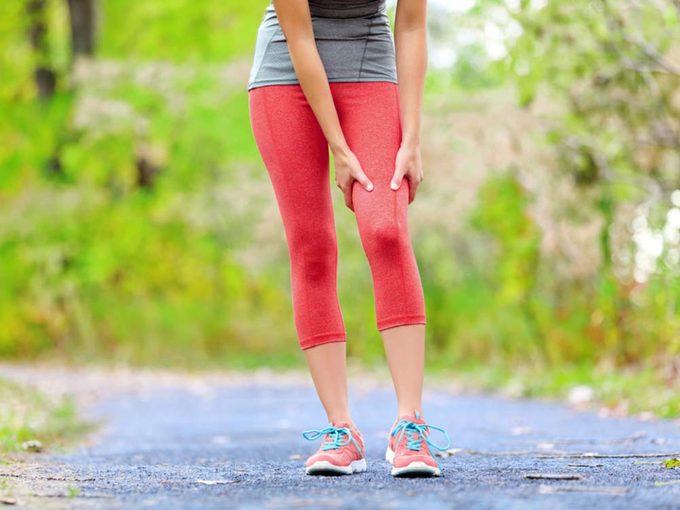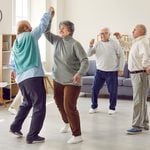What You Need to Know About Delayed Onset Muscle Soreness (DOMS)
You schedule Saturday as your big workout day and feel strong after a great run and an even better session with the weights. You stride out of the gym feeling fit and fabulous. And then you can’t move on Monday. Don’t panic: You’ve got DOMS.

What is DOMS?
Delayed Onset Muscle Soreness (DOMS) occurs after your workout is over, generally 24-72 hours once you’ve finished exercising. It’s a very common experience for everyone—from elite athletes to novice exercisers alike. Symptoms can range from slight muscle tenderness to muscle stiffness, loss of strength and swelling, and can be debilitating. For athletes, it is most prevalent at the beginning of a sports season—when hockey players hit this ice for training, for example. It is also quite common when returning to exercise after a prolonged time away.
Causes and Cures
DOMS is often precipitated by eccentric exercise—when the muscle is shortening and lengthening—such as when you run downhill, plyometrics (exercises designed to produce fast, powerful movement) and resistance training (such as lifting weights, using bands, etc.) to strengthen muscles. Research tells us that microscopic tearing of muscles fibres is the main culprit for DOMS, says Dr. Phil Chilibeck, Chair of the Canadian Society for Exercise Physiology. “Many researchers believe it is inflammation that comes after the microscopic tearing that results in the ‘delayed’ part of DOMS. After microscopic muscle injury, immune cells go to the site of injury to ‘clean things up’ – in other words, repair the damage—which results in the inflammation and pain.”
Although time off from the gym and a full-body massage might seem appealing, heading back to the gym could be the best thing in coping with DOMS. “Repeated exposure to the same exercise stimulus will lessen the DOMS,” says Chilibeck. “Though you might feel the pain for a few days after doing an intense, unfamiliar muscular exercise, if you did the same exercise session a week later the DOMS would be less.” However, this is not to say you need to hit the gym hard. Ideally, you should target body parts that have been less affected, allowing the more affected muscle groups time to recover and build.
If you’re in a lot of pain, maximum strength ibuprofen, an anti-inflammatory drug, can be effective in relieving symptoms. A study published in the Journal of Strength and Conditioning found that ibuprofen can alleviate muscle soreness, but it won’t help with muscle recovery—in other words, even though the pain might decrease, your muscles still won’t be functioning as well for a few days after performing the intense exercise. Unfortunately, while stretching is great for improving flexibility and overall performance, a good stretch at the end of your workout won’t prevent muscles soreness, either. (Slow down and follow these 10 tips for relieving the pain of aching, sore muscles.)
One of the best things you can do to diminish the severity of DOMS is to warm up before you exercise. Although this won’t entirely prevent the onset muscle soreness after a workout, it can help reduce symptoms.
Is It DOMS or Damage?
It is important to understand the difference between muscle strain and DOMS. When you strain a muscle from vigorous exercise, you can worsen the injury if you continue to exercise. In other words, if you have severely strained a calf muscle running, you will have problems walking afterwards. If you have DOMS, your muscles will be stiff and sore, but you’ll be able to walk around, and the symptoms will go away within a few days. (Follow these tips to help speed up your metabolism.)
“With DOMS, you feel the pain in the muscle if you press down on it with your finger,” says Chilibeck.
“Your muscle strength and range of motion are diminished, sometimes for days.” Time is of the essence: If the pain doesn’t go away—if it takes you more than a week to recover—you need to get yourself checked out.
The Bright Side
Remember, DOMS is temporary and is not always a bad thing. “DOMS may be needed for muscles to “adapt” to an exercise stimulus. A muscle is broken down with exercise and when it is built back up and repaired, a greater than normal amount of muscle tissue might be the result,” says Chilibeck. (Professional wrestler and “Dad Bod Destroyer” Robbie E reveals the secret to staying fit after fatherhood.)
The best thing to know about DOMS: It is a step towards getting stronger. And, you know what they say…no pain, no gain.
This is the absolute best way to build muscle, according to science.



